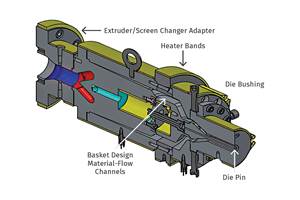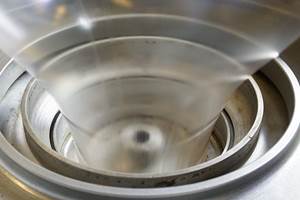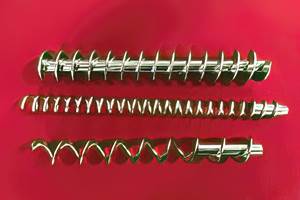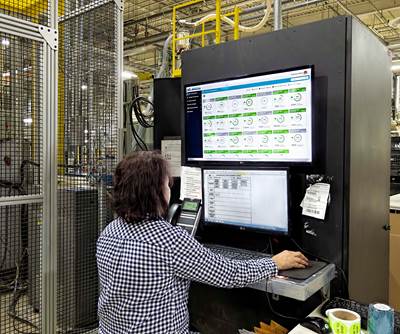To Troubleshoot Profile Extrusion, First Get to Know All the Variables
It requires patience, logical thinking, and a methodical approach to assess each unique problem and solve the problem in a timely fashion.
To troubleshoot any type of processing problem, you need a thorough understanding of the multiple variables that constitute a given process. In profile extrusion, the number of variables is increased by a factor of two, since the basic process of extrusion is complicated by the complexity of unique die design for each profile as well as a calibration segment for cooling the extrudate.
Start off by reviewing the complete profile extrusion “complex,” defined as a five-segment process consisting of extruder, tooling, sizing/cooling, takeoff, and ancillary downstream. Each segment of the profile extrusion process itself can create unique problems, resulting in poor extrudate quality and/or customer rejects. In some cases, a defect could be attributed to multiple segments of the process. This article will provide an overview of the process. Subsequent articles will deal with specific “critical-to-quality” attributes of profile extrusion.
TYPICAL PROBLEMS
Three main categories of problems in profile extrusion plague operators and technicians:
•Aesthetic flaws, such as pits, black specs, pinholes, drag marks, die lines, sink marks, undulations, “turkey-tracks,” and the like. We will cover these in a separate article.
•Size variance, which can be contiguous or intermittent. Depending on its severity, several segments can contribute to this problem.
•Dimensional variations, or flow shifts, which result from a change in the rheology of the plastic, which can be affected by a change in operating conditions.
Solving each of these requires a deep understanding of the process, of each component of the extrusion complex, and of its synergistic effect on the other components.
‘HARDWARE OR SOFTWARE’?
In looking at each segment of the extrusion process, you can identify two distinct areas in which to search out the root cause of a pressing problem. So-called “hardware” issues relate to equipment. On an extruder, the screw, barrel, drive, motor, breaker plate, and any mechanical portion that cannot be readily changed are considered hardware.
“Software” refers to the operating conditions that an operator or technician can readily manipulate, such as screw rpm, temperature settings on the barrel, and screw temperature (see table above).
When a problem occurs, the operators should first look to the software to validate the operating conditions as described on their setup sheets. Are the proper temperatures set for the barrel zones? Are any of the zones underheated? Are any barrel zone temperatures overriding? These are definite signs that the process has been altered or is out of control.
Most importantly, nothing should be changed before validating that the original operating conditions have been checked. All too often, people have opinions on what conditions—such as temperature profile—work best. But using experience alone—without a theoretical basis —can lead to more problems. Case in point: Some operators prefer an “ascending barrel-heat profile,” where the temperature is colder in the feed section and higher in the metering zone (last zone), while others prefer a “reverse profile” where the temperatures in the feed zone are warmer than the metering zone.
While each has its place, the choice must be based on the thermoplastic being used and the screw type at a given output rate and melt temperature. The reverse profile is often used to offset an improper screw design that is creating excessive frictional heat.
In any case, setting the proper barrel temperature profile should not be based on guesswork or preference. It should be based on the hardware and software of the operating setup sheet. The equipment (screw, screen pack, tooling) and operating conditions must be followed in detail where the tool was originally developed.
DISSECT THE PROCESS
Problems of aesthetics, dimensional variation, or flow shifts can be caused by one or more of the five segments of the profile extrusion process as outlined above. The key is to understand the function of each of these components and decouple them for good “root cause analysis.” This is referred to as “dissecting the process.” Focus on one component, and rule it out before moving to another.
Start with the extruder; this is the primary piece of the complex and where most of the action takes place in the process. The screw conveys, then melts, and finally “meters” the thermoplastic, so it plays a key role in the overall process. Are you using the right screw—the one for which the profile die was originally developed? Comparing the setup sheet to the actual screw being used will validate this factor.
Each screw design will give a different output at a given rpm, as well as a unique melt temperature, which impacts melt flow and dimensional control. Next, check the screw temperature. Was the profile die developed with a “neutral temperature” (no screw cooling) or with internal screw cooling by water or oil? What is the listed temperature?
After verifying the temperature profile (per the setup sheet) and validating that there are no heat overrides, look at two or three of the critical indicators of the process: pressure and motor load. Is the pressure range similar to that listed on your setup sheet? What is the range of motor load (amps)? These are very important indicators to tell you what is going on in the extruder.
Troubleshooting requires patience, logical thinking, and a methodical approach to assess each unique problem and solve the problem in a timely fashion.
Related Content
How to Select the Right Tooling for Pipe Extrusion
In pipe extrusion, selecting or building a complementary set of tooling often poses challenges due to a range of qualitative factors. Here’s some guidance to help you out.
Read MoreReduce Downtime and Scrap in the Blown Film Industry
The blown film sector now benefits from a tailored solution developed by Chem-Trend to preserve integrity of the bubble.
Read MorePart 2 Medical Tubing: Use Simulation to Troubleshoot, Optimize Processing & Dies
Simulation can determine whether a die has regions of low shear rate and shear stress on the metal surface where the polymer would ultimately degrade, and can help processors design dies better suited for their projects.
Read MoreWhat to Know About Your Materials When Choosing a Feeder
Feeder performance is crucial to operating extrusion and compounding lines. And consistent, reliable feeding depends in large part on selecting a feeder compatible with the materials and additives you intend to process. Follow these tips to analyze your feeder requirements.
Read MoreRead Next
People 4.0 – How to Get Buy-In from Your Staff for Industry 4.0 Systems
Implementing a production monitoring system as the foundation of a ‘smart factory’ is about integrating people with new technology as much as it is about integrating machines and computers. Here are tips from a company that has gone through the process.
Read MoreBeyond Prototypes: 8 Ways the Plastics Industry Is Using 3D Printing
Plastics processors are finding applications for 3D printing around the plant and across the supply chain. Here are 8 examples to look for at NPE2024.
Read MoreMaking the Circular Economy a Reality
Driven by brand owner demands and new worldwide legislation, the entire supply chain is working toward the shift to circularity, with some evidence the circular economy has already begun.
Read More





















